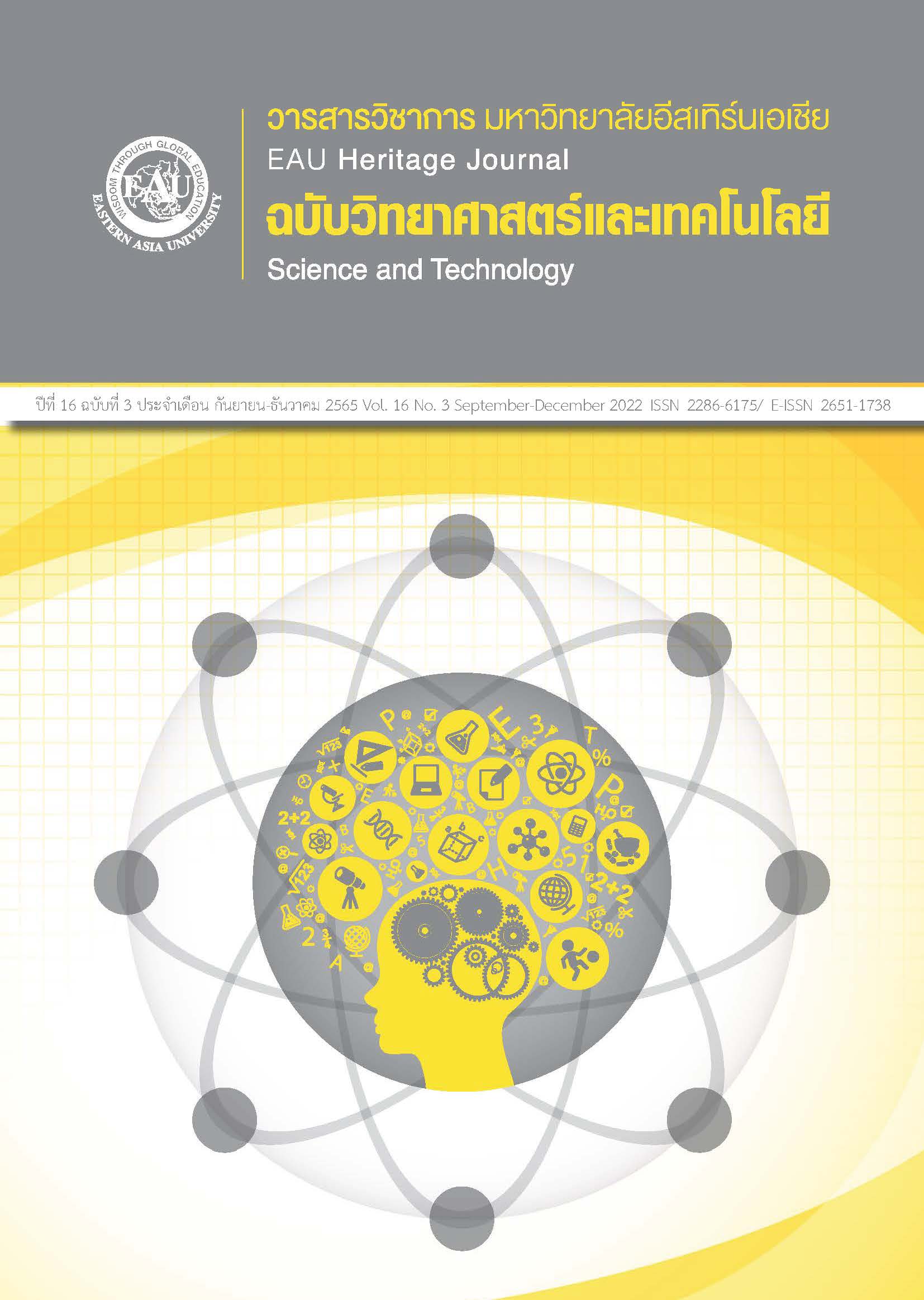การศึกษาประสิทธิภาพถังปฏิกรณ์เอสบีอาร์แบบระบบเติมออกซิเจนใน การบำบัดน้ำเสียชุมชนจากคลองกุดตาโป้ เทศบาลตำบลวัฒนานคร จังหวัดสระแก้ว
คำสำคัญ:
ระบบบำบัดน้ำเสียเอสบีอาร์, น้ำเสียชุมชน, แอมโมเนียมไอออน, ฟอสฟอรัส, ซีโอดีบทคัดย่อ
ระบบบำบัดน้ำเสียด้วยถังปฏิกรณ์เอสบีอาร์ (Sequencing Batch Reactor--SBR) เป็นระบบบำบัดทางชีวภาพที่มีการทำงานแบบกะ (batch) มีประสิทธิภาพในการบำบัดสารอินทรีย์ สารอาหารไนโตรเจนและฟอสฟอรัสที่มีอยู่ในน้ำเสีย ซึ่งถูกพัฒนาขึ้นมาเพื่อให้สามารถควบคุมง่ายและเหมาะสำหรับประยุกต์ใช้ในการบำบัดทั้งน้ำเสียจากชุมชนและน้ำเสียจากอุตสาหกรรมขนาดเล็กที่มีน้ำเสียปริมาณไม่มาก การวิจัยนี้จึงมีวัตถุประสงค์เพื่อต้องการศึกษาประสิทธิภาพของระบบบำบัดน้ำเสียด้วยถังปฏิกรณ์เอสบีอาร์ ที่เหมาะสมสำหรับการกำจัดมลสารในน้ำเสียชุมชนคลองกุดตาโป้ภายใต้สภาวะการบำบัด
แบบเติมอากาศในระบบถังปฏิกรณ์จำลองขนาดปริมาตร 10 ลิตร โดยควบคุมให้ระบบมีค่าออกซิเจนที่ละลายในน้ำ (DO) เท่ากับ 5 มิลลิกรัมต่อลิตร มีความเข้มข้นของตะกอนจุลินทรีย์ (TSS) ในระบบเท่ากับ 3,000 มิลลิกรัมต่อลิตร ซึ่งกระบวนการบำบัดในถังปฏิกรณ์ 1 รอบวัฏจักร กำหนดให้มีช่วงการเติมน้ำเสีย 0.5 ชั่วโมง ช่วงทำปฏิกิริยาภายใต้สภาวะการเติมอากาศ 10 ชั่วโมง ช่วงตกตะกอน 1 ชั่วโมง ช่วงระบายน้ำทิ้งออกจาระบบ 0.5 ชั่วโมง และช่วงพักระบบ 12 ชั่วโมง ตามลำดับ ผลการวิจัยพบว่า ระบบบัดน้ำเสียเอสบีอาร์ภายใต้สภาวะการบำบัดแบบเติมอากาศมีประสิทธิภาพในการบำบัด
ค่าแอมโมเนียมไอออน (NH4-N) เท่ากับร้อยละ 93.62 มีประสิทธิภาพในการบำบัดค่าปริมาณฟอสฟอรัสทั้งหมด (TP) เท่ากับร้อยละ 80.17 มีประสิทธิภาพในการบำบัดค่าซีโอดี (COD) เท่ากับร้อยละ 77.92 มีประสิทธิภาพในการบำบัดค่าไนไตรท์ (NO2-N) เท่ากับร้อยละ 73.30 และมีประสิทธิภาพในการบำบัดค่าไนเตรท (NO3-N) เท่ากับร้อยละ 69.50 พบว่า
ระบบบำบัดน้ำเสียนี้มีประสิทธิภาพในการบำบัดค่าแอมโมเนียมไอออน ค่าปริมาณฟอสฟอรัสทั้งหมด ค่าซีโอดี ค่าไนไตรท์ และค่าไนเตรท ที่มีความแตกต่างกันทางสถิติอย่างมีนัยสำคัญที่ p-value<.05 โดยผลจากการวิจัยแสดงให้เห็นว่าค่าพารามิเตอร์ที่ผ่านการบำบัดนั้นมีค่าไม่เกินกว่าค่ามาตรฐานน้ำทิ้งกำหนดไว้ ซึ่งมีเพียงค่า TSS ที่ไม่เป็นไปตามค่ามาตรฐานกำหนด โดยผลจาการวิจัยนี้เทศบาลตำบลวัฒนานครสามารถนำองค์ความรู้ไปใช้เป็นแนวทางในการวางแผนเพื่อแก้ไขปัญหาน้ำเสียชุมชนที่มีประสิทธิภาพเหมาะสมสำหรับการบริหารจัดการมลพิษในคลองกุดตาโป้ได้ในอนาคต
เอกสารอ้างอิง
Benchakul, T., Dararat, S., & Pung, T. (2009). Efficiency of Ammonia-Nitrogen treatment in synthetic wastewater by Sequencing Batch Reactor. In the 6th KU-KPS Conference (pp. 516). Nakhon Pathom: Kasetsart University. (in Thai)
Chaitakun, C. (2005). Humans and natural resources and environment (Research report). Bangkok: Kasetsart University. (in Thai)
Connie, R. M., Donald, C. L., & George, M. (2007). Textbook of diagnostic microbiology (3th ed.). Missouri: Saunders, an Imprint of Elsevier
Dejtanon, V. (2001). Upgrading the wastewater treatment system using Sequencing Batch Reactor (Master’s thesis). Suranaree University of Technology. Nakhon Ratchasima. (in Thai)
Department of Health, Ministry of Public Health. (1994). Chemical water quality analysis guide (Research report). Bangkok: Thammasat University Printing House. (in Thai)
Fux, C., Boehler, M., Huber, P., Brunner, I., & Siegrist, H. (2002). Biological treatment of ammonium-rich wastewater by partial nitritation and subsequent anaerobic ammonium oxidation (anammox) in a pilot plant. Journal of Biotechnology, 99(3), 295–306. https://doi.org/10.1016/s0168-1656(02)00220-1
Gabriel, B. (2005). Wastewater microbiology (3rd ed.). New Jersey: John Wiley & Sons.
Gray, N. F. (2004). Biology of wastewater treatment (2nd ed.). London: Imperial College Press
Jangkorn, S (2015). Acrylamide degradation with mixed culture bacteria in Sequencing Batch Reactor (SBR) wastewater treatment process. Burapha Science Journal, 20(1), 25-34. (in Thai)
Tchobanoglous, G., Burton, F., & Stensel, D. (2004). Wastewater Engineering Treatment and Reuse (4th ed.). New York: McGraw-Hill Book Company. https://citly.me/Qx8WC
Onrayub, C. (2005). A study of the model and efficiency of a small-scale wastewater treatment system for residential houses in waterfront communities (Master’s thesis). Naresuan University. Phitsanulok. (in Thai)
Pansawat, T. (1987). Community wastewater and water pollution problems in Bangkok and its vicinities (Research report). Bangkok: Office of the National Environment Board, Ministry of Science, Technology and Energy. (in Thai)
Pansawat, T., & Wisuttisak, V. (1997). Wastewater analysis manual (3rd ed.). Bangkok: Society of Environmental Engineers of Thailand. (in Thai)
Pollution Control Department. (2002). Wastewater treatment service provider’s guide (Research report). Bangkok: Rueankaew Printing. (in Thai)
Ratsuk, S., & Klinsukon, C. (1981). Disposal of wastewater from industrial plants and communities. Bangkok: Thailand Institute of Scientific and Technological Research. (in Thai)
Sarathai, Y. (2001). Efficiency of SBR in treating domestic wastewater contaminated with NICKEL (Master’s thesis). Mahidol University. Bangkok. (in Thai)
Siriananpaiboon, S (2006). Wastewater treatment system. Bangkok: Tops. (in Thai)
Tangchawan, V. (2002). Water chemistry and wastewater treatment (Research report). Bangkok: Srinakharinwirot University. (in Thai)
Tanthulwet, M. (1995). Chemistry of water and wastewater (Research report). Bangkok: Chulalongkorn University Printing House. (in Thai)
Utensut, A. (1995). Wastewater management organization (Research report). Bangkok: Ministry of Science, Technology and Environment. (in Thai)
Veeravaynanond, V. (2003). Environmental education (Research report). Bangkok: Odeon Store. (in Thai)







